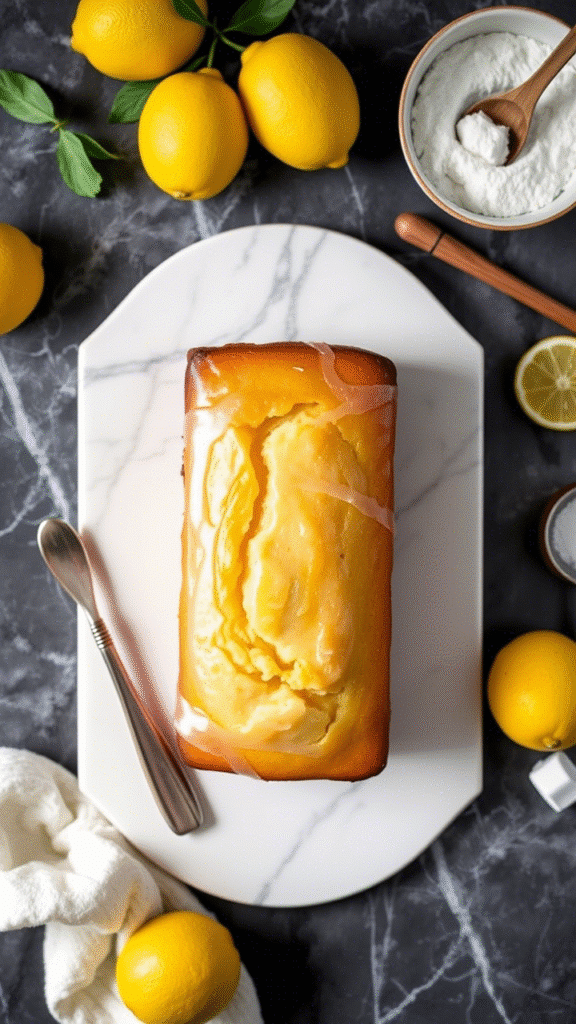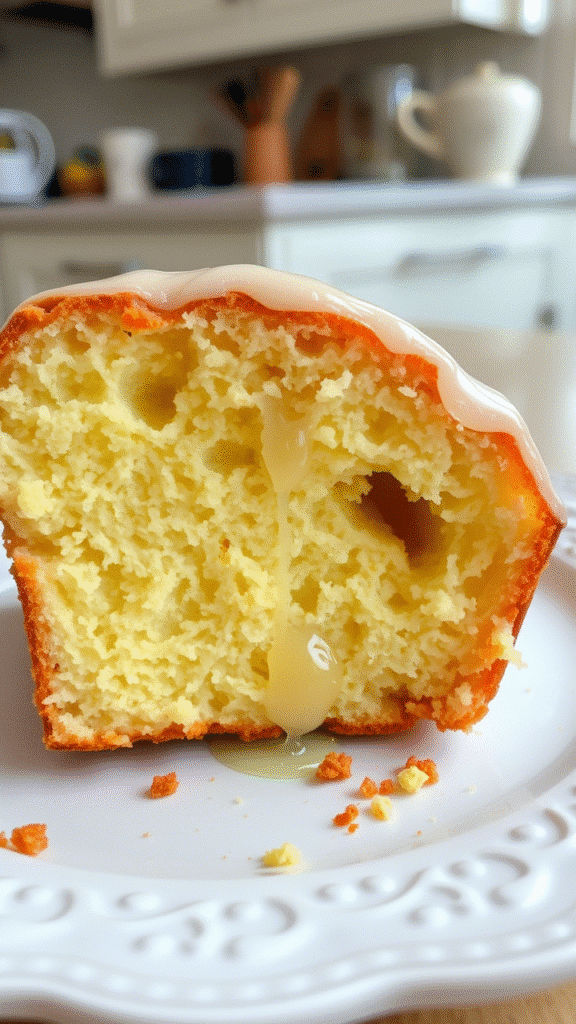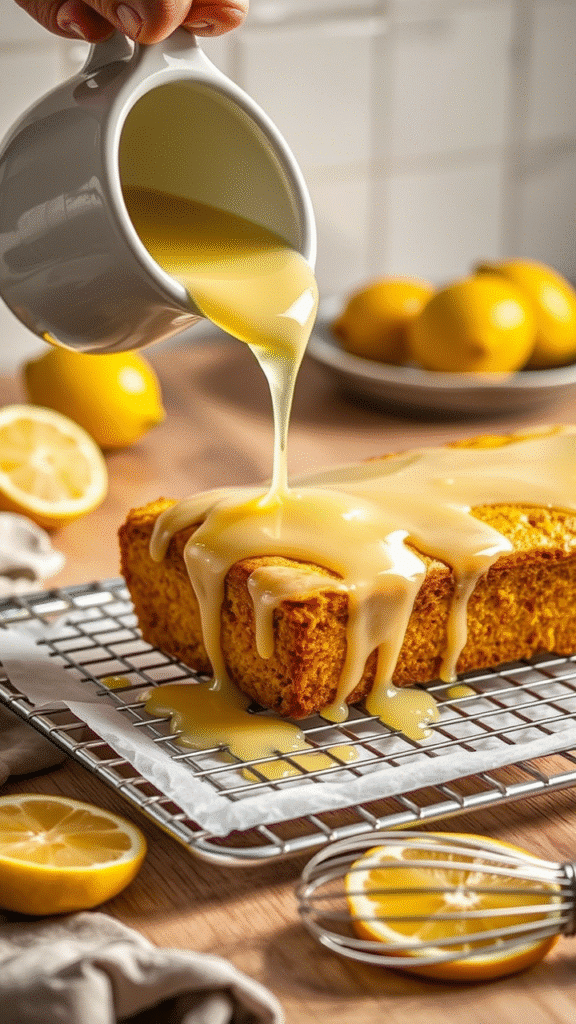I’ll never forget the first time I attempted to recreate Starbucks’ iconic lemon loaf in my own kitchen. After years of professional baking, I was convinced it would be straightforward just another quick bread with some lemon zest, right? Wrong. Three failed attempts later, I realized this deceptively simple-looking loaf holds secrets that separate amateur bakers from those who truly understand the chemistry of citrus in baking.
The Starbucks lemon loaf isn’t just another sweet treat crowding the coffee shop display case. It’s a masterclass in balanced acidity, moisture retention, and that perfect tender crumb that somehow stays moist for days without becoming soggy. What makes this particular copycat recipe special is how it captures that signature dense-yet-fluffy texture while delivering an intense lemon flavor that doesn’t overwhelm your palate.
The Science Behind the Perfect Lemon Loaf
Understanding why this recipe works requires diving into the fundamental chemistry of lemon-based baking. Unlike other citrus fruits, lemons contain both citric acid and pectin in concentrations that dramatically affect gluten development. The acid naturally tenderizes proteins in flour, creating that characteristic soft crumb structure. However, too much acid can cause the batter to become overly tender and collapse during baking.
Professional bakers know that the real secret lies in balancing three forms of lemon: fresh juice for acidity, zest for aromatic oils, and sometimes lemon extract for consistent flavor intensity. The Starbucks version achieves its distinctive taste through careful calibration of these elements, plus one crucial ingredient most home bakers overlook—a touch of vanilla to round out the citrus sharpness.
Ingredients & Substitutions
Dry Ingredients
- 1¾ cups all-purpose flour (spooned and leveled)
- 1 cup granulated sugar
- 1 tablespoon baking powder
- ½ teaspoon salt
- 2 tablespoons fresh lemon zest (from 2-3 large lemons)
Wet Ingredients
- ⅓ cup fresh lemon juice (from 1-2 lemons)
- ⅓ cup vegetable oil or melted butter
- 1 large egg
- 1 cup whole milk
- 1 teaspoon vanilla extract
- ½ teaspoon lemon extract (optional but recommended)
For the Glaze
- 1 cup powdered sugar
- 2-3 tablespoons fresh lemon juice
- 1 tablespoon lemon zest
The flour choice matters more than most realize. All-purpose flour provides the ideal protein content (around 10-12%) for this recipe’s structure. Bread flour creates too dense a texture, while cake flour produces a crumb that’s almost too delicate. If you’re working with European flour, which tends to have higher protein content, reduce the amount by 2-3 tablespoons.
Sugar serves multiple purposes beyond sweetness it helps retain moisture and creates tenderness by interfering with gluten formation. You can substitute up to half the granulated sugar with light brown sugar for a slightly more complex flavor, though this will darken the finished loaf. Coconut sugar works as a 1:1 replacement but will produce a more caramelized taste.
For dietary modifications, the vegetable oil can be replaced with melted coconut oil (cooled slightly) or even applesauce, though the latter will create a slightly denser texture. Greek yogurt makes an excellent substitute for up to half the milk, adding both tang and moisture while reducing overall fat content.
Step-by-Step Instructions

Preparation and Mixing
Preheat your oven to 350°F (175°C) and line a 9×5-inch loaf pan with parchment paper, leaving some overhang for easy removal. This step is crucial don’t skip the parchment, as lemon loaves have a tendency to stick due to their high sugar content.
In a large bowl, whisk together flour, sugar, baking powder, and salt until well combined. Create a well in the center of the dry ingredients this old-fashioned technique ensures even distribution when you add the wet ingredients. Add the lemon zest to the dry ingredients and rub it in with your fingertips. This releases the aromatic oils and prevents the zest from clumping together in the finished loaf.
The wet ingredient preparation requires careful attention to temperature. All ingredients should be at room temperature for optimal emulsification. Cold eggs and milk can cause the batter to seize and create a tough texture. In a separate bowl, whisk together lemon juice, oil, egg, milk, vanilla, and lemon extract until smooth.
The Critical Mixing Phase
Pour the wet ingredients into the well you created in the dry ingredients. Using a spatula or wooden spoon, gently fold the mixture together until just combined. Here’s where many home bakers go wrong they overmix, developing too much gluten and creating a tough loaf. You should still see a few small streaks of flour; the batter will finish coming together during baking.
The properly mixed batter should be thick but pourable, similar to a thick pancake batter. If it seems too thick, add milk one tablespoon at a time. Too thin, and your loaf will sink in the middle during baking.
Baking Technique
Pour the batter into your prepared pan and gently tap it on the counter to release air bubbles. Use a knife to create a shallow score down the center of the loaf this encourages even rising and prevents the top from cracking randomly.
Bake for 50-60 minutes, rotating the pan halfway through for even browning. The loaf is done when a toothpick inserted in the center comes out with just a few moist crumbs attached. The internal temperature should reach 200°F (93°C) for optimal doneness.
Here’s a professional tip: don’t open the oven door for the first 45 minutes of baking. The sudden temperature change can cause the loaf to sink or develop an uneven texture.
Cooking Techniques & Science

Understanding Leavening in Quick Breads
Baking powder serves as the primary leavening agent in this recipe, but the interaction between acid (lemon juice) and the alkaline components creates additional lift. This double-action leavening is why the batter rises immediately when mixed and continues rising in the oven heat.
The creaming method isn’t used here because we want a tender, not fluffy, texture. Instead, this recipe employs the muffin method combining wet and dry ingredients separately, then folding together minimally. This technique prevents overdevelopment of gluten strands that would create a tough, chewy texture.
The Role of Fat in Moisture Retention
Vegetable oil provides superior moisture retention compared to butter because it remains liquid at room temperature. This is why the Starbucks loaf stays moist for days while butter-based quick breads dry out quickly. The oil also creates a more tender crumb structure by coating flour proteins and limiting gluten development.
If you prefer butter for flavor, use melted butter that’s cooled to room temperature. Hot melted butter can cook the eggs in the batter, creating an uneven texture.
Glazing and Finishing Techniques
The Perfect Glaze Consistency
The glaze should be thick enough to coat the back of a spoon but thin enough to spread easily. Start with less lemon juice and add gradually you can always thin it out, but you can’t thicken it without adding more powdered sugar.
For the glossiest finish, add the glaze while the loaf is still slightly warm. The residual heat helps the glaze penetrate the surface, creating that characteristic Starbucks appearance. Allow the glaze to set for at least 30 minutes before slicing.
Professional Glazing Tips
Pour the glaze down the center of the loaf, then use an offset spatula to spread it evenly. Work quickly the glaze sets fast. For a restaurant-quality finish, you can apply two thin coats rather than one thick coat, allowing the first to set completely before adding the second.
Serving & Pairing Suggestions

Presentation Techniques
Slice the lemon loaf with a sharp, serrated knife using a gentle sawing motion. Clean the blade between cuts to maintain clean edges. For professional presentation, slice pieces about ¾-inch thick thin enough to showcase the tender crumb but thick enough to maintain structural integrity.
The loaf benefits from sitting overnight before serving, allowing the flavors to meld and the texture to settle. This is particularly important for the glaze, which needs time to fully set and develop its characteristic appearance.
Complementary Pairings
This lemon loaf pairs beautifully with medium-roast coffee, where the acidity complements rather than competes with the citrus notes. Earl Grey tea creates an elegant pairing, with the bergamot oils echoing the lemon flavors. For afternoon service, consider pairing with vanilla-scented whipped cream or a dollop of mascarpone.
The loaf also works wonderfully as a base for more elaborate desserts. Slice and toast lightly, then serve with fresh berries and whipped cream for an elegant summer dessert. During winter months, pair with candied citrus peel and a drizzle of honey.
Storage and Shelf Life
Optimal Storage Conditions
Store the glazed loaf wrapped tightly in plastic wrap at room temperature for up to five days. The oil-based recipe and glaze create an effective moisture barrier, preventing the loaf from drying out. Refrigeration isn’t necessary and can actually cause the glaze to become sticky.
For longer storage, wrap unglazed loaves in plastic wrap and aluminum foil, then freeze for up to three months. Thaw overnight at room temperature before glazing. The glaze should always be applied fresh frozen glazed loaves often develop a grainy texture upon thawing.
Troubleshooting Common Issues
Dense or Heavy Texture
A dense loaf usually results from overmixing the batter or using too much flour. Always spoon flour into measuring cups and level with a knife scooping directly from the bag can pack in up to 30% more flour than the recipe calls for.
Check your baking powder’s expiration date. Old leavening agents lose potency and won’t provide adequate lift. Replace baking powder every six months for optimal results.
Sunken Center
A sunken center typically indicates underbaking or opening the oven door too early in the baking process. The loaf needs time to set its structure before the oven door is opened. Always test for doneness with a toothpick, and don’t rely solely on timing.
Glaze Issues
Grainy glaze results from using too much lemon juice or not sifting the powdered sugar. Always sift powdered sugar before making glaze to eliminate lumps. If the glaze becomes too thick, add lemon juice one teaspoon at a time until you reach the desired consistency.
Seasonal Variations
Meyer Lemon Version
When Meyer lemons are in season, substitute them for regular lemons using a 1:1 ratio. Meyer lemons have a sweeter, more floral flavor that creates a more delicate loaf. Reduce the sugar by 2 tablespoons to compensate for the Meyer lemons’ natural sweetness.
Lemon-Poppy Seed Variation
Add 2 tablespoons of poppy seeds to the dry ingredients for a classic bakery-style variation. The poppy seeds add textural interest and a subtle nutty flavor that complements the lemon beautifully.
Professional Tips for Commercial Production
Scaling the Recipe
This recipe scales easily for commercial production. When making larger batches, mix dry ingredients in a stand mixer with the paddle attachment for consistent distribution. Add wet ingredients slowly to prevent overmixing.
For consistent results across multiple batches, weigh ingredients rather than using volume measurements. Professional bakers know that weight measurements provide much more accurate results than cups and spoons.
Quality Control
Maintain detailed baking logs, noting oven temperatures, humidity levels, and baking times. Lemon loaves are particularly sensitive to environmental conditions, and keeping records helps identify patterns when problems arise.
The Cultural Impact of Starbucks Lemon Loaf
This particular lemon loaf has become more than just a coffee shop pastry it’s a cultural touchstone that represents accessible luxury. The recipe’s popularity stems from its perfect balance of familiar comfort and sophisticated flavor. Unlike many coffee shop pastries that prioritize appearance over taste, this loaf delivers genuine satisfaction with every bite.
Understanding why this recipe works so well provides insight into successful product development in the food industry. The combination of familiar ingredients, consistent quality, and memorable flavor creates the kind of product that generates customer loyalty and word-of-mouth marketing.
Conclusion
Mastering the Starbucks copycat lemon loaf requires understanding both the science and artistry of citrus baking. The recipe’s success lies in its careful balance of acidity, moisture, and texture—elements that work together to create a loaf that’s both indulgent and refined. The techniques outlined here will help you achieve consistent, professional-quality results that rival the original.
The most important takeaway is patience. Great lemon loaves can’t be rushed. From properly room-temperature ingredients to adequate cooling time, each step contributes to the final product’s success. Master these fundamentals, and you’ll have a recipe that serves you well whether you’re baking for family or running a commercial operation.
Remember that baking is both science and art. While following the recipe precisely is important, developing your palate and understanding your ingredients will help you make adjustments for different climates, altitudes, and personal preferences. The best bakers are those who understand not just what to do, but why they’re doing it.
Frequently Asked Questions?
Can I make this recipe gluten-free?
Yes, but you’ll need to use a high-quality gluten-free flour blend that contains xanthan gum. Bob’s Red Mill 1-to-1 Baking Flour or King Arthur Gluten-Free Measure for Measure work well. The texture will be slightly different a bit more crumbly but the flavor remains excellent. Add an extra tablespoon of milk if the batter seems too thick.
Why is my lemon loaf bitter?
Bitterness usually comes from too much pith (the white part under the lemon skin) being included with the zest. When zesting lemons, only remove the colored outer layer, avoiding the white pith underneath. Using a micro plane grater gives you better control than a traditional box grater. Also, check that your lemons are fresh older lemons can develop bitter compounds.
How can I make the lemon flavor more intense?
For more pronounced lemon flavor, increase the lemon zest to 3 tablespoons and add the optional lemon extract. You can also brush the warm loaf with a simple syrup made from equal parts lemon juice and sugar before glazing. This technique, called “soaking,” is commonly used in professional bakeries to intensify flavors.
Can I use bottled lemon juice instead of fresh?
Fresh lemon juice provides significantly better flavor than bottled versions, which often contain preservatives that can create off-tastes. If you must use bottled juice, reduce the amount by about 25% as bottled juice tends to be more acidic. The zest should always be fresh there’s no adequate substitute for fresh lemon zest.
My loaf cracked on top despite scoring it. What went wrong?
Top cracking despite scoring usually indicates the oven temperature was too high or the loaf was placed too close to the top heating element. Try reducing the temperature by 25°F and baking slightly longer. Also ensure your oven is properly calibrated many home ovens run hot. Using an oven thermometer can help you identify temperature discrepancies.

Veronica is a passionate food enthusiast with over three years of experience in exploring and writing about diverse cuisines. Her expertise lies in reviewing restaurants, sharing creative recipes, and discovering the latest food trends. As the voice behind FoodieRecap.com, Anju brings fresh perspectives and culinary insights to her audience.
